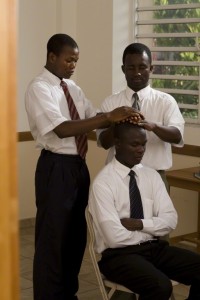 This article is one in a series of articles about explaining our Mormon beliefs to our friends. See other articles in this series.
This article is one in a series of articles about explaining our Mormon beliefs to our friends. See other articles in this series.
Some members of the Church are not prepared to answer questions when asked why blacks were not ordained to the priesthood before 1978.
Here are some resources with information to help you answer such questions:
- Read the topic “Priesthood Ordination before 1978” on LDS.org. You can find it in the menu on LDS.org by clicking Teachings > Gospel Topics > “Priesthood Ordination before 1978.” You may also want to read the topic “Priesthood.”
- Read the article “Race and the Church: All Are Alike Unto God” from the Church’s Newsroom.
- Watch the video “Blacks and the Priesthood” from the YouTube channel Understanding Mormonism, where a member of the Church posts videos explaining his Mormon beliefs in a simple, authentic way.
I hope you find these resources helpful.
What other ideas do you have that you can share with others? Post them in the comments below.


If I may be so bold as to throw my hat in the ring, I wrote an article on this topic for Meridian Magazine, entitled “Race in Mormon History.” I performed a good amount of research on the topic. I hope it is of use: http://ldsmag.com/1/article/9406
I think blacks might never have been denied the priesthood had Joseph Smith lived for another couple of decades. Joseph ordained at least one black man to the priesthood, and Emma Smith asked Jane Manning (a young black woman) to be sealed to Joseph and herself as an adopted daughter. [Jane Manning refused at the time, since her own parents were alive and well.]
When Joseph was slain, those who followed in his footsteps made tactical decisions to protect the Saints. One particular challenge involved William McCary, a black man who was baptized and ordained to the Melchizedek priesthood after Joseph Smith’s death. McCary began to claim direct revelation from various personages from the Bible and Book of Mormon. When McCary was excommunicated, he set up a competing version of Mormonism near Winter Quarters and attracted various converts, including a number of white women who became McCary’s plural wives. Official statements regarding bans on priesthood or temple ordinances for black people occurred after the McCary scandal.
This is similar to the reaction of the State of California in 1920-30 to scandals involving relationships between white women and Filipino men. In one case, Terry Santiago, a Filipino worker, stabbed a white dance hall girl twenty-two times. In another case, the Filipino husband of a white woman murdered her white lover. The State of California made sure neighboring western states adopted laws against mixed race marriages, which is why my parents had to travel out of state to get married, and their marriage was among those considered Void and Prohibited in the state of my birth when I was born [Mom tells me I don’t get to claim I was illegitimate, however, since I was born in the Covenant and reciprocity between the states means marriages legally performed in other states are almost always recognized by the other 49 states, even when local law would have banned the marriage].
A side effect of the Mormon priesthood ban for blacks was the belief that this ban would be lifted, and that its lifting would be a marvelous event, a sign from heaven heralding Christ’s eventual triumphant return. Mormons almost universally wanted the ban to lift, and everyone I know of was thrilled when the policy changed.
I read a fantastic article about black and the priesthood in the LDS Living magazine several years ago but I can’t find it anywhere. It told the story of one particular African American man and his perspective about why the priesthood was withheld from black men for a time. He counted it as a blessing and I loved his insights and explanations. I do not remember his name. Can you help me find this article? Thanks!
Becky,
I found a few such articles on LDSLiving.com. See http://www.ldsliving.com/search?q=priesthood+race+black
Is it one of these?